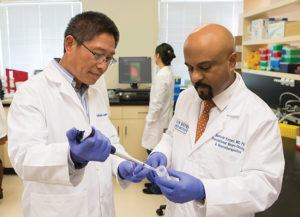
Cancer Clinical Trials: Pushing the Pace of Progress
by Zara Jethani
Written by SANDI DRAPER
An expansion of cancer clinical trials gives patients additional options
Clinical trials are the lifeblood of medical advances. Without these studies, new treatments would simply not emerge. That’s why the Saint John’s Cancer Institute in partnership with Providence Saint John’s Health Center and Pacific Neuroscience Institute has significantly expanded its clinical trials program in recent years and hopes to have approximately 30 trials underway by the end of 2017.
Lisa van Kreuningen, director of clinical research operations at the Institute, attributes the impressive expansion of clinical trials to the active recruiting of physicians who also pursue research. “Clinical trials are the only way to test whether new treatments are safe and effective. Without clinical trials, new treatments can’t be approved,” van Kreuningen says.

The Saint John’s Cancer Institute has a long history of involvement in grant-funded clinical trials, studies that are typically funded by the National Institutes of Health, says van Kreuningen. In fact, the Institute has a unique specimen repository—a blood and tissue bank—that has been a rich resource for cancer studies. The repository was started in 1971, long before most in the medical field realized that such tissue would be vital to cancer research.
Today, however, many physicians are pursuing their own grants, often funded by major pharmaceutical companies. These trials are typically fast-paced studies focusing on a specific, promising therapy. Many of the Institute’s clinical trials spring from laboratory studies aimed at understanding the biology of a tumor and individual patient response, according to neuro-oncologist Santosh Kesari, MD, PhD. Diverse strategies are needed to tackle complex disease, from testing innovative new agents as well as repurposing existing therapies.
One especially active area of clinical trials at the Institute focuses on cancer immunotherapy. This type of treatment uses certain parts of a patient’s own immune system to fight disease. Cancer occurs when cells “go rogue.” Immunotherapy can tell the body to fight off cancer cells. With adoptive T-cell immunotherapy, researchers determine which white blood cells are best suited for fighting cancer, then genetically engineer the cells to strengthen them before returning them to the patient.
Another trial underway at the Institute is aimed at helping patients with recurrent glioblastoma multiforme, a form of brain cancer. Pacific Neuroscience Institute was the first facility in Los Angeles to offer the Optune system as part of a clinical trial. The device is a band that fits around the patient’s head and provides a specific electromagnetic field that prevents cancer cells from growing. While now approved for glioblastoma, the Optune system is being used with the chemotherapy agent temozolomide in a phase II study under the direction of Dr. Kesari.
 Patients can participate in clinical trials several ways. The most common is by participating in the testing of a new drug or treatment protocol. Another way is called procurement— meaning patients agree to donate blood or tissue to the Institute tissue repository to be used as part of future trials.
Patients can participate in clinical trials several ways. The most common is by participating in the testing of a new drug or treatment protocol. Another way is called procurement— meaning patients agree to donate blood or tissue to the Institute tissue repository to be used as part of future trials.
Some people are reticent about participating in a clinical trial, fearing they will not get the best possible treatment. In fact, patients in clinical trials may receive the best possible standard treatment including more frequent monitoring of their disease, or a promising experimental treatment that may be even more effective. “There are many, many protections in place,” van Kreuningen says. “The regulatory requirement for informed consent helps to ensure that no one is included in a study without being completely informed about risks and benefits of participation before, during and after the study.”
Before a clinical trial is allowed to enroll patients, an Institutional Review Board (IRB) analyzes all study-related materials then conducts periodic reviews of the study. Patients have multiple avenues to find clinical trials that may benefit them, including reputable internet sources such as clinicaltrials.gov, the website operated by the National Institutes of Health.
Dr. Kesari, who joined Pacific Neuroscience Institute, the Institute and Providence Saint John’s in 2015, says he has seen many patients benefit by enrolling in clinical trials. His research involves immunotherapy, molecular genetics, innovative drug development for cancer stem cells and development of biomarker-based clinical trials for cancers.

“Clinical trials offer potentially life-saving new treatments for patients who have highly malignant cancers such as brain, pancreatic, skin or liver cancers as well as metastatic cancers to the brain from primary cancers such as breast and lung cancer where current treatments often fail,” Dr. Kesari says. “Participation in trials is essential to making progress in the fight against cancer.”
TYPES OF CLINICAL TRIALS
Clinical trials are structured to ensure the study is conducted properly. The guidelines state who will be able to join the study and the treatment plan. The principal investigator is in charge of the study and prepares a plan for the study, called a protocol, which is like a recipe for conducting a clinical trial. The protocol explains what the trial will do, how the study will be carried out and why each part of the study is necessary. For a treatment to become standard, it must first go through three or four clinical trial phases:
Phase I / Purpose:
• To find a safe dose
• To decide how the new treatment should be given
• To see how the new treatment affects the human body
• Number of people taking part: 15 to 30
Phase II / Purpose:
• To determine if the new treatment has an effect on a certain cancer
• To see how the new treatment affects the human body
• Number of people taking part: fewer than 100
Phase III / Purpose:
• To compare the new treatment (or new use of a treatment) with the current standard treatment
• Number of people taking part: from 100 to several thousand
Phase IV / Purpose:
• To further assess the long-term safety and effectiveness of a new treatment
• Number of people taking part: several hundred to several thousand
Resource: National Cancer Institute
For more information on clinical trials, contact Dr. Kesari at 310-829-8265 or neuro.oncology@jwci.org.
Adapted from WINTER 2017 Breakthroughs Magazine published by Providence Saint John’s Health Center.
About the Author

Zara Jethani
Zara is the marketing director at Pacific Neuroscience Institute. Her background is in molecular genetics research and healthcare marketing. In addition, she is a graphic designer with more than 20 years experience in the healthcare, education and entertainment industries.
Last updated: August 2nd, 2019